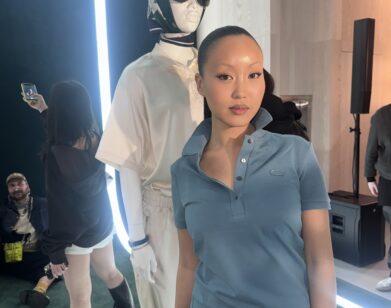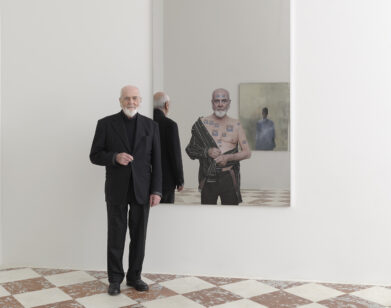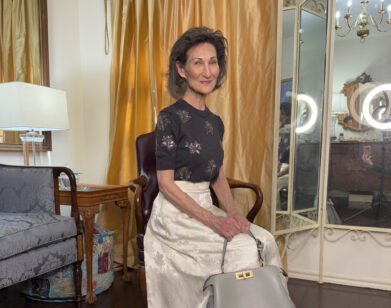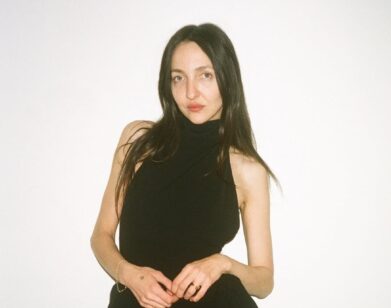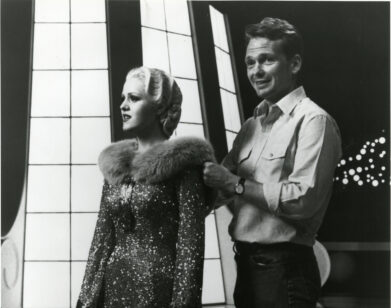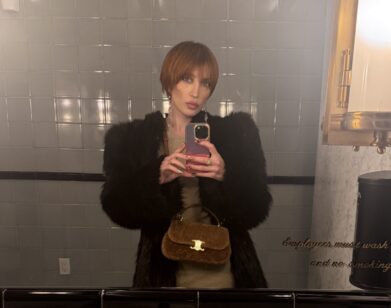ACCESSIBILITY
Aaron Rose Philip and Collina Strada Are Making History at the Met
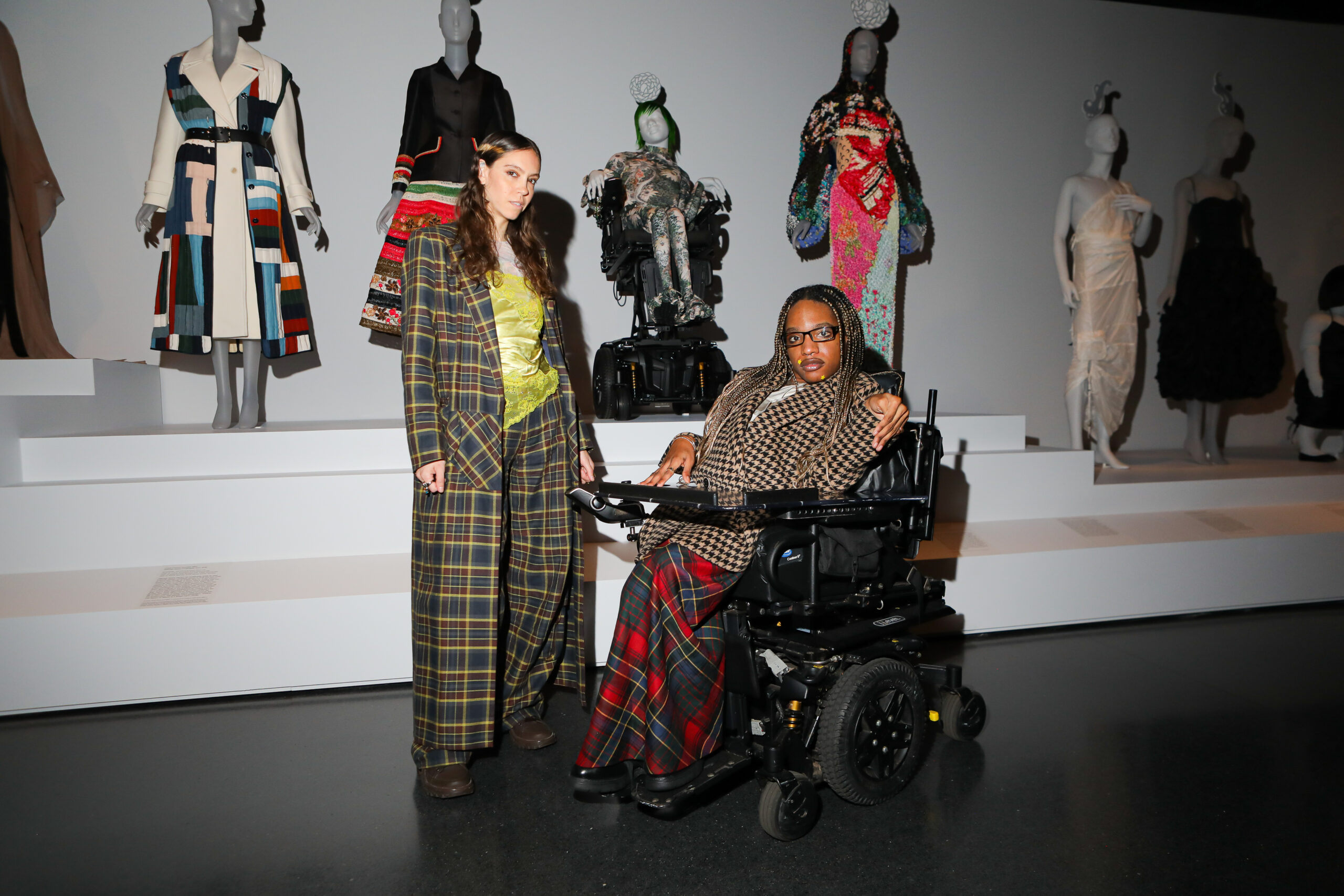
BFA.com/Hippolyte Petit
The Met Costume Institute’s Fall 2023 exhibition Women Dressing Women features the work of over seventy womenswear designers, spanning all the way from 1910 to today. It’s the first time that the museum has held a show dedicated specifically to the work of women, with a goal of facilitating a larger conversation between industry veterans of all generations and abilities, including Collina Strada designer Hillary Taymour and one of her muses, the model Aaron Rose Philip, who both worked with museum curator Mellissa Huber and installation manager Joyce Fung to design a mannequin in Aaron’s likeness (accompanied by a custom look by Taymour and a wheelchair loaned by Quantum Rehab). To learn more about the inclusive high-fashion collaboration, we invited the trio to discuss bad venues, body scans, and embracing humans of all sizes, ages, races, and abilities.
———
MELLISSA HUBER: Hi both. How are you doing?
AARON ROSE PHILIP: I’m so happy. How are you?
HUBER: Good. It’s exciting to talk to you both on the opening day of Women Dressing Women.
ROSE PHILIP: I know. Congratulations to us all and to everyone. We’re really showing the men.
HILLARY TAYMOUR: I know. I’m super excited to be a part of it.
HUBER: It’s been such an exciting project to work on and I’ve really enjoyed our collaboration. We have this custom mannequin with Collina Strada accessories and headpieces and all of the accoutrements together. It’s one of my favorite moments in the show and it’s been such a pleasure to work with you both on that.
ROSE PHILIP: Honestly, it’s been my pleasure seeing all of this pan out. When the idea was presented, I couldn’t believe it. I used to go to the Met Costume Institute as a child and see these mannequins. So to think for even one second that I would ever be a part of it blew my mind. I didn’t know how y’all was going to go about it, and then to see the process and how you managed to include disability access in the conversation was really inspiring.
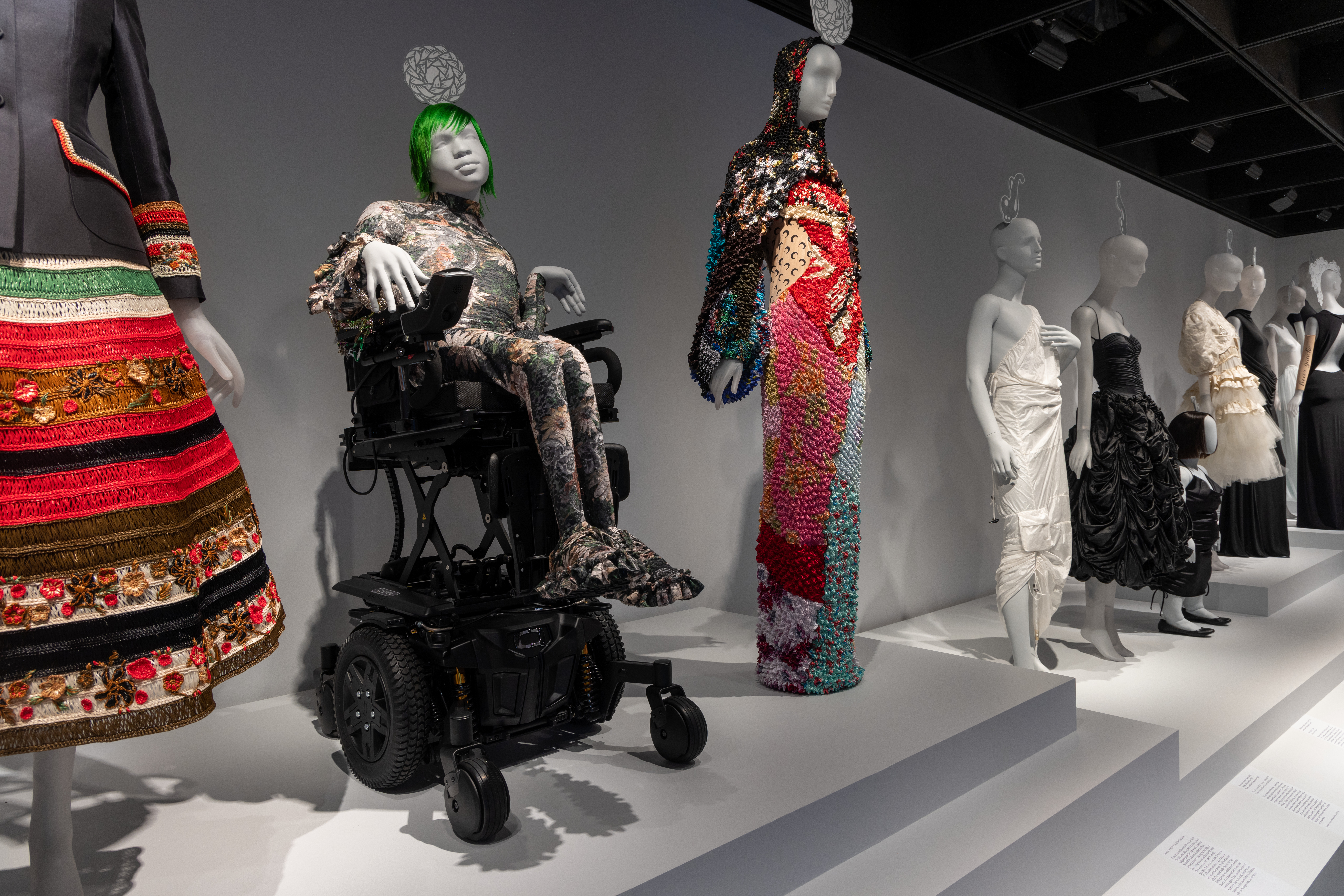
© The Metropolitan Museum of Art
HUBER: That’s really amazing to hear. Having the opportunity to show that there’s so many different ways that women navigate the world and that not all women customers have the same needs or interests was really important to the process.
ROSE PHILIP: It was so crucial because I feel like disability already is such a highly disregarded portion of the fashion industry, whether you are a consumer or you’re someone that enjoys fashion.The fact that every single one of you at the Costume Institute took the time to make this possible with Collina Strada was fantastic. I think about Hillary and Charlie [Engman] and their commitment to inclusivity and how wonderful that really is.
HUBER: There is this long history of designers talking about who their ideal woman is or who their customer is, but when you look at a Collina Strada runway show, the casting is so diverse and you have all ages, sizes, races, and aspects of ability. It really sends home this message that your clothes are for everyone and that you don’t have to be a certain way to wear Collina Strada. It doesn’t feel like it’s political or trying to be heavy-handed. Is that how you’ve always worked?
TAYMOUR: We try to make it, “If you’re into it, you’re into it and you can be a part of it if you like it.” It doesn’t need to be like, “My customer’s an 18 to 35 year old working girl.” But a lot of designers, they pick a muse, and then they cater to that girl. Whereas I am like, what is Elva going to wear? What is Aaron going to wear? What is Giselle going to wear? I have all my humans that I love to work with and I create looks based on what I want to see them wearing or what I feel like is good for them. Having multiple muses creates this well-rounded, diverse, and inclusive show. I hate using those words, but that’s just what it is.
ROSE PHILIP: You’re right.
HUBER: I remember when we were talking, you were sharing how you work so closely with your models, you dress them yourself. You don’t have armies of assistants and you’re not removed from the process. You spoke a little bit about how that experience of actually working with all of your models and potential clientele really informed your understanding of how they need to move and how they present the pieces on the runway. I’m curious if you feel like that’s changed the way that you work over the years?
TAYMOUR: It definitely changed the looks in the show. I really style based off of the person. So that it feels like it’s their essence, and something I think they should or would wear. Sometimes it takes a while, and then I see there’s a moment where their face lights up and you can tell that they feel great and they love the look. So I try to cater to that as much as I can during the process, because those are the moments where you’re like, “They feel great, and they’re going to give you all they have on the runway.”
HUBER: I’m curious, Aaron, how did you feel about that experience going to France and modeling for a mannequin?
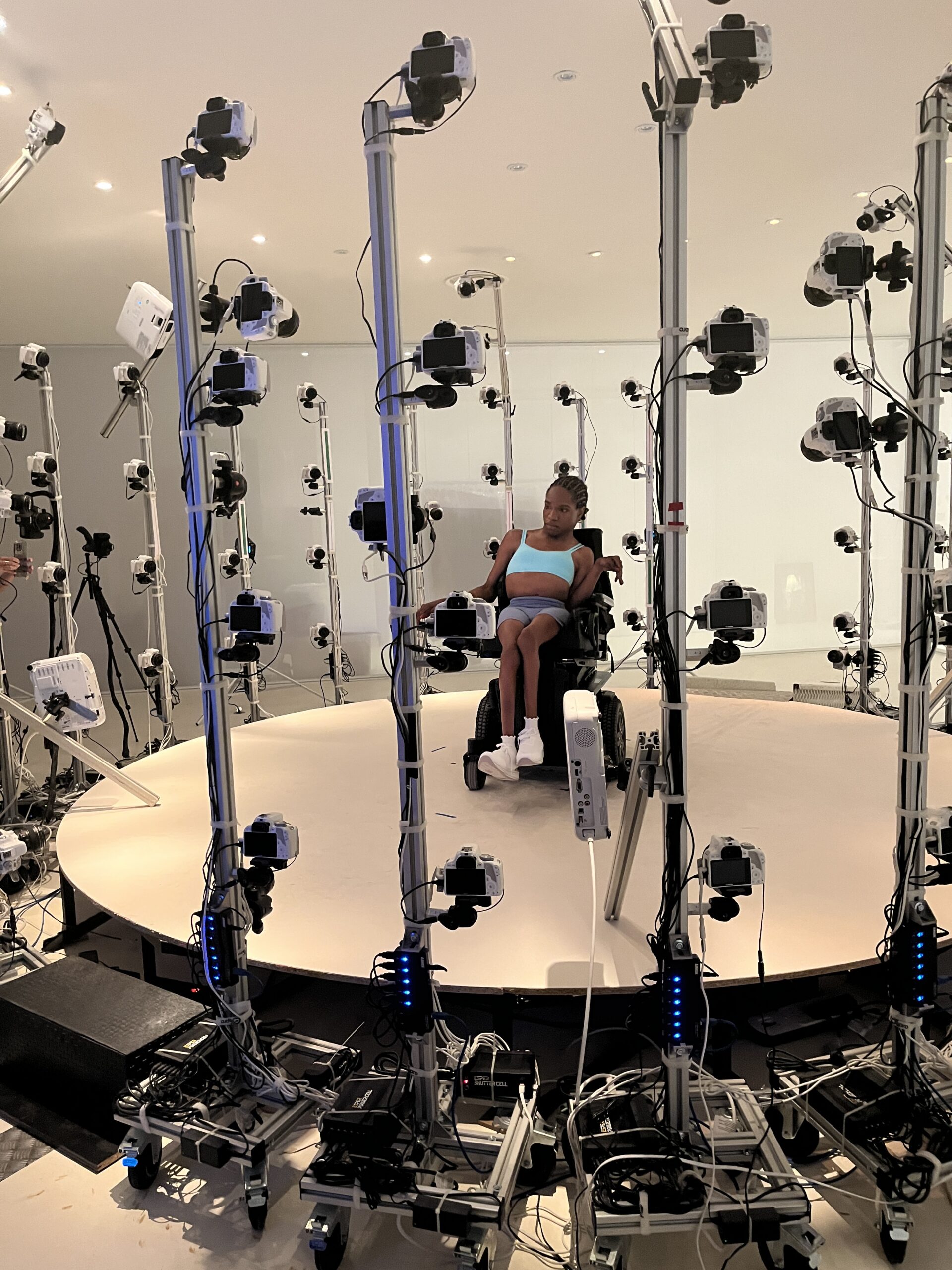
Photos by Mellissa Huber. Courtesy of The Metropolitan Museum of Art
ROSE PHILLIP: My first time ever in France was with you guys doing this project, so that was already such a huge honor for me. But then being able to have the experience of being body scanned for a look was amazing. Honestly, I’m gentle, so I will say when I sat on the clear block so that they could scan my butt, that’s when it hurt. But I felt so futuristic and sci-fi when they had all of the cameras surrounding me and scanning me. I had to do different poses and I had to stay really still for a really long amount of time. You’re not even getting the shot. You’re literally creating a mannequin with your body.
HUBER: I have to say, watching you that day, it really underscored for me that modeling really is hard work and I think that it’s easy to write it off. We often see the final photo or 30 seconds on the runway, but thinking about all of the fittings and posing—you did it with such an amazing attitude and you brought such infectious enthusiasm to the whole day. Everyone was just buzzing.
ROSE PHILIP: Of course. How could I not?
TAYMOUR: Mellissa actually reached out to me the day before my Please Don’t Eat My Friends show. I had this email from you being like, “Can you introduce me to Aaron?” It was so hard to wait the whole day of my fashion show not to tell her, because I knew if I did she’d be too gagged and it would ruin her serious model mode. And so I had to tell her after the show and then we both cried.
HUBER: I feel like there’s been a lot of tears with the show. Even my colleagues who came down throughout the installation process have been really touched by the beauty of the representation and just how exciting it is and meaningful for all of us to have this moment in the exhibition. It’s been such a pleasure to work with you all and the other extended community that you’ve brought in, like Evanie Frausto who recreated the wig from the show for the mannequin. Aaron, I’m curious about when you first got into modeling and if you feel like you had someone who mentored you along the way?
ROSE PHILIP: I never get tired of answering this question, because my journey into modeling was very atypical and DIY. I was not scouted on the street, I did not have it given to me at all whatsoever. I started on social media, because I was a teenager from the Bronx who had this immense love and infatuation with fashion and the glistening glamor of it, but I was disillusioned with the fact that I never saw anyone like myself who happened to be physically disabled or Black and trans. I confronted those ideas around 16, 17. I used Twitter, which is now X, to make tweets about wanting a modeling contact. Then, by the grace of God, I went mega-viral. Paper magazine profiled me that winter, in 2018. That is when I started doing some freelance work, but I was not yet in high fashion, which is where I knew the real inequity was for people like myself.
HUBER: Right.
ROSE PHILIP: Then Hunter Schaeffer, who is one of my dear friends, introduced me to Richie [Keo] at Elite. It was that July that Richie was like, “We want to confirm you.” I cried my eyes out when I signed with them.
HUBER: Working with Window France and seeing the way that Richie advocated for everything that needed to happen in the space to make sure that it was accessible for all of us was amazing. It made me look around at the environment with new eyes, and it also underscored how, not only is collaborating with a really wide range of people so important in terms of providing that extra layer of beauty and representation to others, but also how the very process of logistical consideration also makes the world a better place.
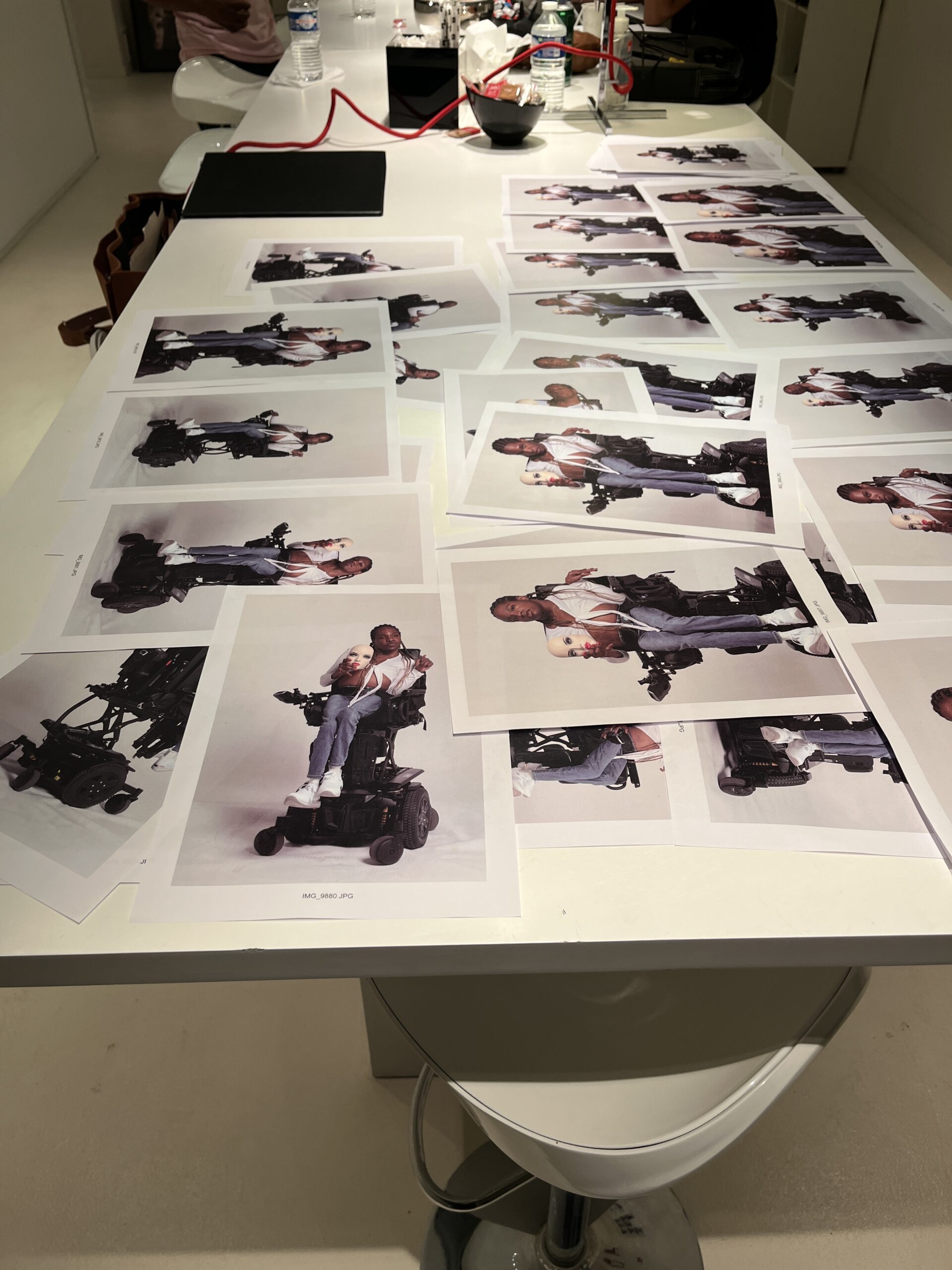
Photos by Mellissa Huber. Courtesy of The Metropolitan Museum of Art
TAYMOUR: When we’re looking for locations for shows, the first thing we ask is, “How do I get my girls in there?” I think a lot of people don’t do it out of fear that they’re going to make a mistake. It’s so funny to me because the things I’ve put you through, Aaron, are wild. I mean, we’ve been on construction sites, we’ve been in outdoor parks, and your disability has never come into play. It’s always been fine.
ROSE PHILIP: We’ve done everything to the max. We’ve created such incredible moments together, and we keep creating examples of what the world can look like, that you can also have disabled talent, like myself, who are going to hit every cue and eat up the looks and sell the garment.
TAYMOUR: You’re so good at it too. Seeing you in the morning at a show, it just lights up my day.
HUBER: Speaking of serving, what do you both hope that visitors to Women Dressing Women might take away from the exhibition when they come in and see this amazing moment in history?
ROSE PHILIP: I want the world to love Collina Strada, first and foremost, because Collina Strada deserves every good thing that consumers, buyers, editors, and the public can possibly afford to that brand. Everybody loves Collina honey, because Collina is for everyone.
TAYMOUR: Yeah, that’s beautiful. Also, it was so amazing to see on Monday how everyone was flocking to our piece and taking photos of us versus everyone else. They were kind of ignoring everything else going on, and it felt like such a vital step for the industry’s history.
ROSE PHILIP: It’s so monumental what you’ve done, Hillary, and I have so much love in my heart for you and the Costume Institute, Mellissa. The fact that you were receptive to this in the first place and made this happen—
TAYMOUR: It was her idea.
HUBER: It’s been such an unforgettable and important part of this exhibition and really of my larger career, to be able to do this together with you both and with all of the extended family that were so important, including Joyce and Richie and Evanie and Caitlin Keogh who made the head pieces. I hope that, and I suspect in fact, that the energy will continue to be really palpable and that the viewers are going to continue to respond to it too.
ROSE PHILIP: Congratulations to us. We ate that.

